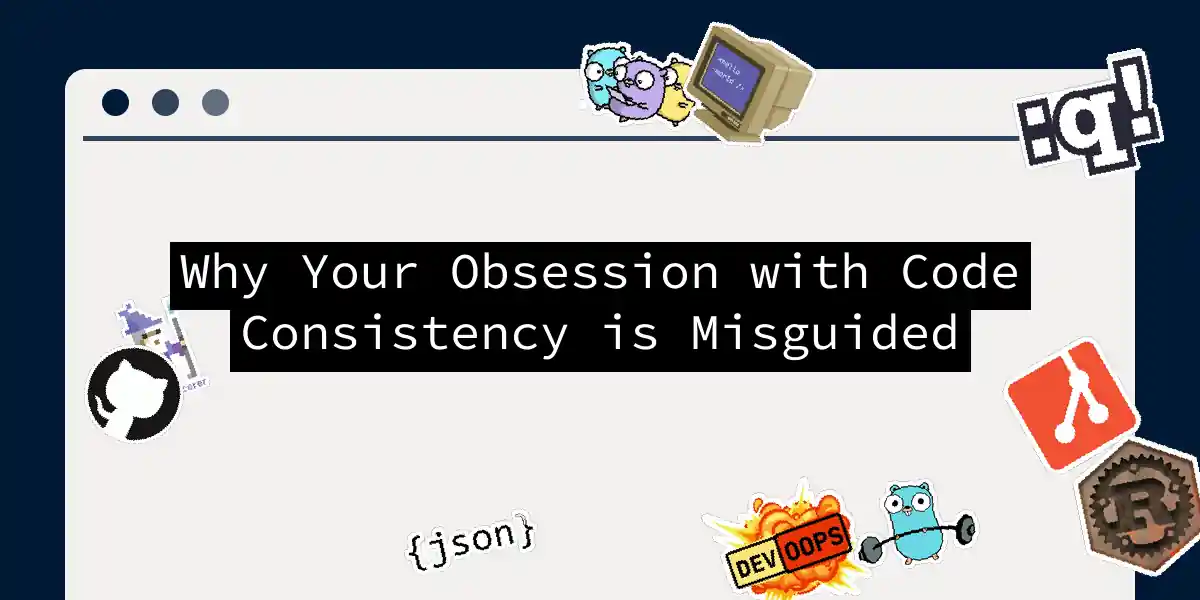We’ve all been there - staring at a pull request debate about whether to use tabs or spaces, or arguing about comma placement while the real problems simmer unattended. Code consistency has become the holy grail of software teams, but what if I told you your meticulous style guides might be sabotaging your productivity? Buckle up, buttercup – we’re about to take a joyride through the minefield of coding dogmatism.
The Tyranny of the Linter Lords
Let’s start with a confession: I once rejected a critical bug fix because variable names weren’t camelCased. The production outage lasted three hours. My team’s glares could’ve melted steel. This toxic perfectionism stems from three dangerous myths:
- Consistency = Quality
Newsflash: You can write consistently terrible code. I’ve seen codebases where every file religiously followed style guides yet resembled Rube Goldberg machines. Remember:// Bad but 'consistent'function processData(unformattedData){let fD = JSON.parse(unformattedData);return fD.map( i => { return { ...i, processed: true } })}
This passes most linters but violates every readability principle. Consistent? Yes. Good? Absolutely not. - One Style to Rule Them All
JavaScript has 7 ways to declare functions. But most teams enforce单一 (that’s Mandarin for “single”) style. Why? When I asked a colleague, they sheepishly admitted: “The style guide says so.” Not exactly Aristotle-level reasoning. - Automation Solves Everything
Prettier worshippers, gather ‘round:These tools are fantastic – until they reformat your carefully constructed data visualizations into illegible spaghetti. True story: our finance dashboard looked like abstract art after a “helpful” auto-format.// .prettierrc { "semi": false, "singleQuote": true, "trailingComma": "none" }
The Innovation Tax
Remember when React hooks seemed weird? Teams clinging to “consistent” class components missed the performance revolution. Here’s the cold truth:
- Pattern paralysis strikes when consistency trumps improvement
- Onboarding delays occur when new hires memorize style docs instead of domain logic
- Toolchain stagnation happens when “but our linter doesn’t support it” blocks modern tools
This flowchart isn’t hypothetical – I’ve watched teams reject GraphQL because “our REST endpoints are consistent.”
The Principles Over Pedantry Manifesto
Ready for the antidote? Ditch rigid rules for these guiding lights:
- The Why-Driven Rulebook
Instead of: “Always use arrow functions”
Try: “Use arrow functions to preservethiscontext, but regular functions when hoisting matters”
See the difference? Understanding > memorization. - The 80/20 Enforcement Principle
- Automate the trivial (formatting, spacing)
- Manual review the critical (architectural patterns, error handling)
Example workflow:
# Step 1: Auto-format non-negotiables npx prettier --write . # Step 2: Human review for substance git diff | grep -vE '^( |\+{3}|-{3})' - Context-Aware Consistency
Context Consistent Approach Flexible Approach Legacy Systems Maintain existing patterns Wrap with adapters Greenfield Projects Establish core conventions Allow experimentation Critical Modules Strict interfaces Internal flexibility
The Art of Strategic Inconsistency
My favorite productivity hack: the sandbox file. When prototyping:
- Create
/experimental/yourname_playground.js - Disable linter rules:
/* eslint-disable */ - Build the damn thing
- Refactor into consistent patterns AFTER validation
// Step 1: The "messy proof"
function quickDirtyValidation(data) {
/* ... */
}
// Step 2: The polished version
export const validateUserSchema = (input) => {
/* ... */
}
This approach birthed our award-winning passwordless auth system – which would’ve died in code review under “consistent” patterns.
The Grand Compromise
Here’s the bitter pill to swallow: perfect consistency sacrifices velocity. The math is brutal:Time Saved by Consistency < Time Spent Enforcing It
A case study from my fintech days:
- Team A (dogmatic): 2 PR reviews/day, 40% rejected on style
- Team B (pragmatic): 5 PR reviews/day, 10% rejected for functional issues
After 3 months, Team B’s code was messier but shipped 3x faster with fewer production bugs. Why? They focused on what the code did, not how it looked.
The Liberation Checklist
Before you next reject a PR for style violations, ask:
- Does this impact functionality?
- Would fixing this create meaningful knowledge sharing?
- Is this worth delaying the release?
If you answered “no” to all three – let it go. Your CI pipeline will survive one extra blank line. Probably. The truth staring us in the face? Code consistency is like salt – essential in the right amounts, destructive when overused. Stop worshiping at the altar of uniformity and start building software that solves real problems. Now if you’ll excuse me, I have a date with a minified script and a linter config file I’m about to delete.
